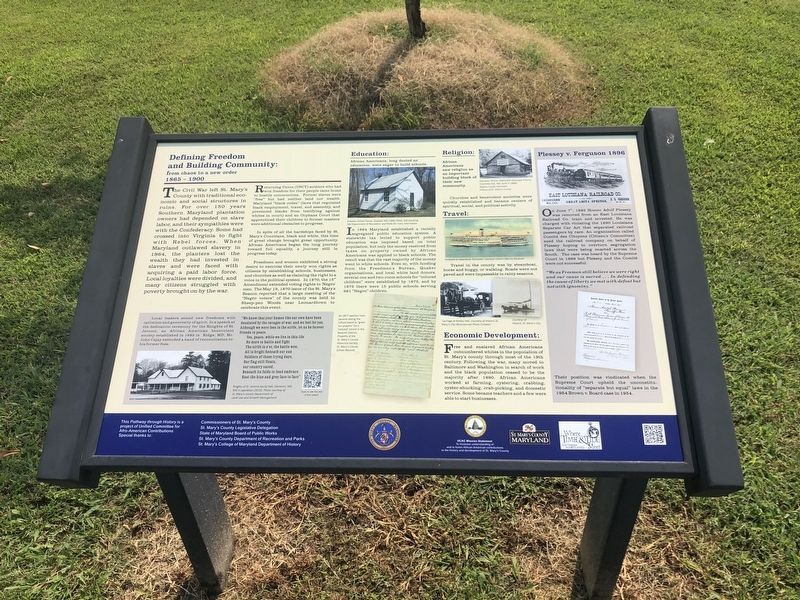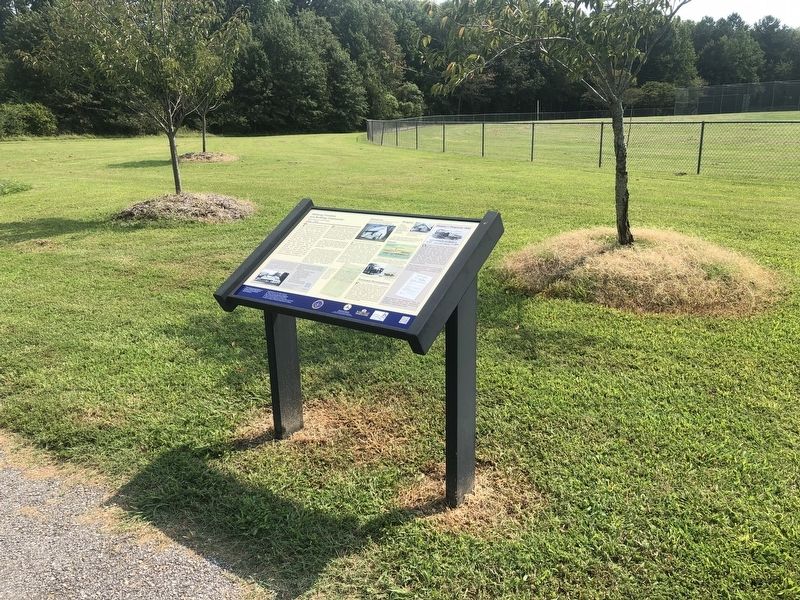Lexington Park in St. Mary's County, Maryland — The American Northeast (Mid-Atlantic)
Defining Freedom and Building Community
from chaos to a new order
— 1865 - 1900 —

Photographed By Devry Becker Jones (CC0), September 12, 2021
1. Defining Freedom and Building Community Marker
The Civil War left St. Mary's County with traditional economic and social structures in ruins. For over 150 year Southern Maryland plantation owners had depended on slave labor, and their sympathies were with the Confederacy. Some had crossed into Virginia to fight with Rebel forces. When Maryland outlawed slavery in 1864, the planters lost the wealth they had invested in slaves and were faced with acquiring a paid labor force. Local loyalties were divided, and many citizens struggled with poverty brought on by the war.
Returning Union (USCT) soldiers who had won freedom for their people came home to hostile communities. Former slaves were "free" but had neither land nor wealth. Maryland "black codes" (laws that regulated black employment, travel, and assembly, and prevented blacks from testifying against whites in court) and an Orphans Court that apprenticed their children to former masters were additional obstacles to process.
In spite of all the hardships faced by St. Mary's Countians, black and white, this time of great change brought brought great opportunity. African Americans began the long journey toward full equality, a journey still in progress today.
Freedmen and women exhibited a strong desire to exercise their newly won rights as citizens by establishing schools, businesses, and churches as well as claiming the right to a voice in the political system. In 1870, the 15th Amendment extended voting rights to 'Negro' men. The May 19, 1870 issue of the St. Mary's Beacon reported that a large meeting of the "Negro voters" of the county was held in Sheep-pen Woods near Leonardtown to celebrate this event.
Education:
African Americans, long denied an education, were eager to build schools.
In 1864 Maryland established a racially segregated public education system. A statewide tax levied to support public education was imposed based on total population, but only the money received from taxes on property owned by African Americans was applied to black schools. The result was that the vast majority of the money went to white schools. Even so, with funding from the Freedmen's Bureau, Quaker organizations, and local white land donors, several one and two-room schools for "colored children" were established by 1872, and by 1875 there were 15 public schools serving 681 "Negro" children.
Religion:
African Americans saw religion as an important building block of their new community.
Churches and benevolent societies quickly established and became centers of spiritual, social, and political actiity.
Travel:
Travel in the county was by steamboat, horse and buggy, or walking.

Photographed By Devry Becker Jones (CC0), September 12, 2021
2. Defining Freedom and Building Community Marker
Economic Development:
Free and enslaved African Americans outnumbered whites in the population of St. Mary's county through most of the 19th century. Following the war, many moved to Baltimore and Washington in search of work and the black population ceased to be the majority after 1890. African Americans worked at farming, oystering, crabbing, oyster-shucking, crab-picking, and domestic service. Some became teachers and a few were able to start businesses.
[Sidebars:]
Local leaders seized new freedoms with optimism and generosity of spirit. In a speech at the dedication ceremony for the Knights of St. Jerome, an African American benevolent society established in 1885 in Ridge, MD, Mr. John Cajay extended a hand of reconciliation to his former foes:
"We know that your homes like our own have been desolated by the ravages of war, and we feel for you. Although we were foes in the strife, let us be forever friends in peace.
Yes, peace, while we live in this life
No more to battle and fight
The strife is o'er, the battle won,
All is bright beneath our sun
Soldiers of those trying days,
Our flag still floats,
our country saved,
Beneath its folds in fond embrace
Rest the blue and grey face to face"
Plessey v. Ferguson 1896
On June 7th, 1892 Homer Adolf Plessey was removed from an East Louisiana Railroad Co. train and arrested. He was charged with violating the 1890 Louisiana Separate Car Act that separated railroad passengers by race. An organization called Comité des Citoyens (Citizen's Committee) sued the railroad company on behalf of Plessey hoping to overturn segregation laws that were being enacted across the South. The case was heard by the Supreme Court in 1896 but Plessey and the Comité were not successful.
"We as Freemen still believe we were right and our cause is sacred … In defending the cause of liberty we met with defeat but not ignominy."
Their position was vindicated when the Supreme Court upheld the unconstitutionality of "separate but equal" laws in the 1954 Brown v. Board case in 1954.
Erected by Commissioners of St. Mary's County; St. Mary's County Legislative Delegation; State of Maryland Board of Public Works; St. Mary's County Department of Recreation and Parks; St. Mary's College of Maryland Department of History.
Topics and series. This historical marker is listed in these topic lists: African Americans • Churches & Religion • Civil Rights • Education. In addition, it is included in the Quakerism series list. A significant historical date for this entry is May 19, 1870.
Location. 38° 15.658′ N, 76° 26.942′ W. Marker is in Lexington Park, Maryland, in St. Mary's County. Marker is on Rennell Avenue West, 0.2 miles east of Willows Road, on the left when traveling east. Touch for map. Marker is at or near this postal address: 21550 Willows Rd, Lexington Park MD 20653, United States of America. Touch for directions.
Other nearby markers. At least 8 other markers are within walking distance of this marker. United States Colored Troops (a few steps from this marker); A "War to end all Wars" (a few steps from this marker); Sergeant James H. Harris (a few steps from this marker); United States Colored Troops (USCT) (a few steps from this marker); Private William H. Barnes (a few steps from this marker); Two Worlds / One County (within shouting distance of this marker); The Great Depression and New Opportunities (within shouting distance of this marker); Lexington Park (within shouting distance of this marker). Touch for a list and map of all markers in Lexington Park.
Credits. This page was last revised on September 13, 2021. It was originally submitted on September 13, 2021, by Devry Becker Jones of Washington, District of Columbia. This page has been viewed 155 times since then and 22 times this year. Photos: 1, 2. submitted on September 13, 2021, by Devry Becker Jones of Washington, District of Columbia.